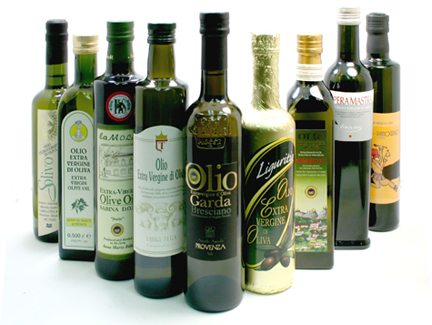Question: I own every kind of oil there is: olive oil, extra virgin olive oil, canola, peanut oil etc, but I don’t know all of the differences, which is healthiest or when to use them. Can you explain?
Answer: Below are some common oils and how to best use them. But first, some oil basics:
- All oils are 100% fat, so every single kind has 120 calories and 14 grams of fat per tablespoon. So no matter what kind of oil you use, do so in moderation.
- Almost all oils are more heart-healthy than butter/animal fat, because they’re comprised of mostly unsaturated fat. Whenever possible, swap out butter/lard for the better-for-you oils.
- You probably hear a lot about “Monounsaturated” and “Polyunsaturated” fats, the two kinds of unsaturated fats found in oil. Every oil has a different ratio of these fats, so to make sure you get some of each, use a variety of oils in your kitchen (2-3 kinds is fine).
- Oils go “rancid” (they spoil & smell/taste bad) after a few months, so buy in small quantities unless you’ll be using them frequently.
- Extra Virgin Olive Oil— A good household staple. Great balance of mono and poly-unsaturated fats, mechanically pressed so not chemically refined, and great flavor. Different brands/regions have different flavors, so experiment to find the ones you like best. Use for drizzling, in salads and raw foods, or for cooking when you want added flavor.
- Regular Olive Oil — Chemically refined (unlike virgin & extra-virgin) which means it loses some polyphenols (antioxidants), but much cheaper than extra virgin, so if you’re budgeting, use this one in cooking and extra virgin for salads/raw foods. Very light flavor, so a good choice for people who don’t like the fruity/grassy taste of extra virgin.
- Canola Oil — Another good household staple. Has no flavor so it’s great for baking, Asian & Mexican cooking (when you want flavorless oil), and pan-frying. Canola oil has gotten a bad rap, but don’t believe the hype. Read here for info.
- Vegetable Oil — Flavorless, high smoking point (so it’s good for frying) good for baking. I’d choose canola over vegetable oil for the mono/poly fat ratio, but vegetable oil is cheap and popular.
- Soybean Oil — No need to stock this in your kitchen, because it’s in pretty much every commercial/processed food we eat.
- Palm Kernel Oil — This is what most processed/packaged food companies are now using in place of trans fats, which have become taboo. Beware of products that have palm kernel oil, because 80% of it’s fat is saturated–worse than butter!
- Safflower/Sunflower Oil — Flavorless, like canola or vegetable oil, and a good mix of unsaturated fats. Low in saturated fat. Good for same things as canola and vegetable oils.
- Grapeseed Oil — Very light flavor and high smoking point, so good for many uses. More polyunsaturated fats than most oils, which is good because most Americans don’t get enough polyunsaturated fats.
- Peanut Oil — Light flavor and very high smoking point, so best oil for frying (not that I recommend frying as a cooking method!)
- Sesame Oil — Intense sesame flavor, so a little goes a long way. Fantastic for Asian sauces and dressings, because you don’t have to use much and therefore can keep the fat/calorie content of these dressings low. One of my favorite recipes using sesame oil.
- Walnut Oil — High in Omega-3 fatty acids, and delicious nutty flavor. Use in salad dressings and when only lightly cooking something that you want to have lots of flavor.
- Coconut Oil — The only oil that’s high in saturated fat (the bad kind) — it has twice as much saturated fat per tablespoon as butter! This oil has been getting lots of hype lately, but I don’t know any nutritionists who’d recommend it.
- Flaxseed Oil — Most people buy this as a supplement because they want more Omega-3 fatty acids. Yes it’s healthy, but but in my opinion it’s better to eat fish, walnuts, and avocado for Omega-3’s, rather than add this oil to things you already eat (because unless you’re reducing calories and fat somewhere else in your diet, you’ll gain weight).
What I use: In my kitchen, I always have extra virgin olive oil (what I mostly use), canola oil (for baking, Mexican, Asian), sesame oil (for Asian dishes & dressings), and grapeseed oil (because it’s cheap and high in polyunsaturated fats). I also keep butter on hand (gasp!) for occasional baking and spreading on warm, homemade bread 🙂





5 Comments
katie
May 11, 2010 at 9:31 pmThis is getting bookmarked as a go-to list for oils. I always get mixed up on which one is good for what – Meels, you give great, totally useful and easily accessible advice. THANKS!!!! Sending love from Colombia!
physician assistant
May 13, 2010 at 12:42 amGreat site. A lot of useful information here. I’m sending it to some friends!
Laura Pagels
May 28, 2015 at 11:47 amWonderful information to keep on hand. Thanks for posting.
Bill Fisher
March 28, 2017 at 10:13 amI want an oil that is COMPLETELY TASTELESS so I can make my own salad dressings, and not have that awful oil taste. What is it, please. Please advise via e-mail, as I’ll probably never find this web-site, again. Thank you very much.
Amelia Winslow
April 11, 2017 at 4:59 amHi Bill,
Canola, sunflower, and safflower oils don’t carry any flavor.